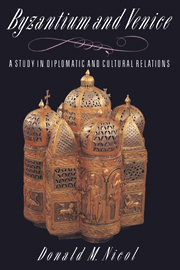Book contents
- Frontmatter
- Contents
- Dedication
- Preface
- List of abbreviations
- Maps of the Byzantine and Venetian worlds
- 1 Venice: the Byzantine province
- 2 Venice: the Byzantine protectorate
- 3 Venice: the ally of Byzantium
- 4 Venice: the partner of Byzantium
- 5 Byzantium, Venice and the First Crusade
- 6 The parting of the ways
- 7 The calm before the storm
- 8 The Fourth Crusade
- 9 Venice in Byzantium: the Empire of Romania
- 10 Venice: champion of a lost cause
- 11 Byzantium, Venice and the Angevin threat
- 12 Byzantium, Venice and Genoa
- 13 Conflicting interests and competing claims
- 14 Byzantium, Venice and the Turks
- 15 Byzantium: the victim of commercial rivalry
- 16 The profit and honour of Venice
- 17 Jewels for an island
- 18 Byzantium in thrall to the Turks and in debt to Venice
- 19 Byzantine optimism and Venetian vacillation
- 20 Byzantium the suppliant of Venice
- 21 The worst news for all of Christendom: Venice and the fall of Constantinople
- 22 Legacies and debts
- Byzantine Emperors
- Doges of Venice
- Bibliography
- Index
6 - The parting of the ways
Published online by Cambridge University Press: 01 April 2010
- Frontmatter
- Contents
- Dedication
- Preface
- List of abbreviations
- Maps of the Byzantine and Venetian worlds
- 1 Venice: the Byzantine province
- 2 Venice: the Byzantine protectorate
- 3 Venice: the ally of Byzantium
- 4 Venice: the partner of Byzantium
- 5 Byzantium, Venice and the First Crusade
- 6 The parting of the ways
- 7 The calm before the storm
- 8 The Fourth Crusade
- 9 Venice in Byzantium: the Empire of Romania
- 10 Venice: champion of a lost cause
- 11 Byzantium, Venice and the Angevin threat
- 12 Byzantium, Venice and Genoa
- 13 Conflicting interests and competing claims
- 14 Byzantium, Venice and the Turks
- 15 Byzantium: the victim of commercial rivalry
- 16 The profit and honour of Venice
- 17 Jewels for an island
- 18 Byzantium in thrall to the Turks and in debt to Venice
- 19 Byzantine optimism and Venetian vacillation
- 20 Byzantium the suppliant of Venice
- 21 The worst news for all of Christendom: Venice and the fall of Constantinople
- 22 Legacies and debts
- Byzantine Emperors
- Doges of Venice
- Bibliography
- Index
Summary
AS he lay on his deathbed John II nominated his youngest son Manuel Komnenos as his heir. His two older sons, Alexios and Andronikos, had recently died and he had no confidence in his third son Isaac. It fell to Manuel, young though he was, to lead his father's army back to Constantinople, there to secure his position as emperor. His coronation by the patriarch set the seal of legitimacy on his succession to the throne. Manuel shared his father's conviction of his unique status as Emperor of the Romans, claimant to a sovereignty that had once been, and would again in God's good time become, universal. Yet he was personally attracted by many aspects of western, Latin life and culture; and he was enough of a realist to see that the Byzantines could no longer bury their heads in the sand of their own mystique and hope that the westerners, the German Emperor, the Normans, the Italians, the papacy and the crusaders would melt away. To cement his alliance with the Germans against the Normans of Sicily, John II had arranged that Manuel should marry Bertha of Sulzbach, sister-in-law of Conrad III. Manuel's admiration for western culture was shaken when she reached Constantinople in 1142. Bertha was plain and dull and stubborn. In the end, however, Manuel took her to wife and she became his empress with the less Teutonic name of Eirene. The Eastern and Western Empires were now united against their common enemy, the Norman Kingdom of Sicily; and Manuel was able to return to the east to continue the campaign that had been interrupted by his father's death.
- Type
- Chapter
- Information
- Byzantium and VeniceA Study in Diplomatic and Cultural Relations, pp. 84 - 103Publisher: Cambridge University PressPrint publication year: 1989



